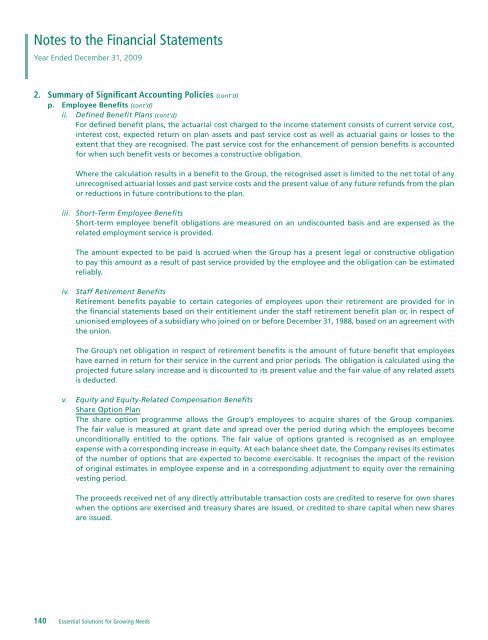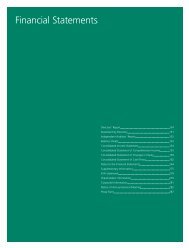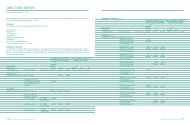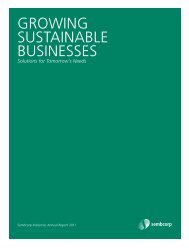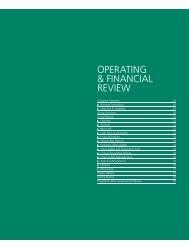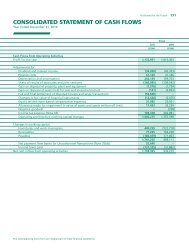Statutory Reports - Sembcorp
Statutory Reports - Sembcorp
Statutory Reports - Sembcorp
- No tags were found...
You also want an ePaper? Increase the reach of your titles
YUMPU automatically turns print PDFs into web optimized ePapers that Google loves.
Notes to the Financial StatementsYear Ended December 31, 20092. Summary of Significant Accounting Policies (cont’d)p. Employee Benefits (cont’d)ii. Defined Benefit Plans (cont’d)For defined benefit plans, the actuarial cost charged to the income statement consists of current service cost,interest cost, expected return on plan assets and past service cost as well as actuarial gains or losses to theextent that they are recognised. The past service cost for the enhancement of pension benefits is accountedfor when such benefit vests or becomes a constructive obligation.Where the calculation results in a benefit to the Group, the recognised asset is limited to the net total of anyunrecognised actuarial losses and past service costs and the present value of any future refunds from the planor reductions in future contributions to the plan.iii. Short-Term Employee BenefitsShort-term employee benefit obligations are measured on an undiscounted basis and are expensed as therelated employment service is provided.The amount expected to be paid is accrued when the Group has a present legal or constructive obligationto pay this amount as a result of past service provided by the employee and the obligation can be estimatedreliably.iv. Staff Retirement BenefitsRetirement benefits payable to certain categories of employees upon their retirement are provided for inthe financial statements based on their entitlement under the staff retirement benefit plan or, in respect ofunionised employees of a subsidiary who joined on or before December 31, 1988, based on an agreement withthe union.The Group’s net obligation in respect of retirement benefits is the amount of future benefit that employeeshave earned in return for their service in the current and prior periods. The obligation is calculated using theprojected future salary increase and is discounted to its present value and the fair value of any related assetsis deducted.v. Equity and Equity-Related Compensation BenefitsShare Option PlanThe share option programme allows the Group’s employees to acquire shares of the Group companies.The fair value is measured at grant date and spread over the period during which the employees becomeunconditionally entitled to the options. The fair value of options granted is recognised as an employeeexpense with a corresponding increase in equity. At each balance sheet date, the Company revises its estimatesof the number of options that are expected to become exercisable. It recognises the impact of the revisionof original estimates in employee expense and in a corresponding adjustment to equity over the remainingvesting period.The proceeds received net of any directly attributable transaction costs are credited to reserve for own shareswhen the options are exercised and treasury shares are issued, or credited to share capital when new sharesare issued.2. Summary of Significant Accounting Policies (cont’d)p. Employee Benefits (cont’d)v. Equity and Equity-Related Compensation Benefits (cont’d)Performance Share PlanThe fair value of equity-related compensation is measured using the Monte Carlo simulation method as atthe date of the grant. The method involves projecting future outcomes using statistical distributions of keyrandom variables including share prices and volatility of returns.In estimating the fair value of the compensation cost, market-based performance conditions are takeninto account. Therefore, for performance share grants with market-based performance conditions, thecompensation cost is charged to the income statement with a corresponding increase in equity on a basis thatfairly reflects the manner in which the benefits will accrue to the employee under the plan over the serviceperiod to which the performance period relates, irrespective of whether this performance condition is satisfied.Restricted Stock PlanSimilar to the Performance Share Plan, the fair value of equity-related compensation is measured using theMonte Carlo simulation method as at the date of the grant. The method involves projecting future outcomesusing statistical distributions of key random variables including the share price and the volatility of returns.This model takes into the account the probability of achieving the performance conditions in the future.The fair value of the compensation cost is measured at grant date and spread over the service period to whichthe performance criteria relates and the period during which the employees become unconditionally entitledto the shares. The compensation cost is charged to the income statement with a corresponding increase inequity on a basis that fairly reflects the manner in which the benefits will accrue irrespective of whether thisperformance condition is satisfied.At the balance sheet date, the Company revises its estimates of the number of performance-based restrictedstocks that the employees are expected to receive based on the achievement of non-market performanceconditions and the number of shares ultimately given. It recognises the impact of the revision of the originalestimates in employee expense and in a corresponding adjustment to equity over the remaining vesting period.In the Company’s separate financial statements, the fair value of options, performance shares and restrictedstocks granted to employees of its subsidiaries is recognised as an increase in the cost of the Company’sinvestment in subsidiaries, with a corresponding increase in equity over the vesting period.vi. Cash-Related Compensation Benefits<strong>Sembcorp</strong> Challenge BonusThe Group recognises a liability and an expense for bonuses and profit-sharing, based on a formula thattakes into consideration the share price of the Company. The Group recognises a provision when contractuallyobliged to pay or where there is a past practice that has created a constructive obligation to pay.The compensation cost is measured at the fair value of the liability at each balance sheet date and spreadover the service period to which the performance criteria relates and the period during which the employeesbecome unconditionally entitled to the bonus. The liability takes into account the probability of achieving theperformance conditions in the future.Until the liability is settled, the Group will re-measure the fair value of the liability at each balance sheet dateand at the date of settlement, with any changes in fair value recognised in the income statement for theperiod.140 Essential Solutions for Growing Needs<strong>Sembcorp</strong> Industries Annual Report 2009 141


